The Holocaust in Bohemia and Moravia
The Holocaust in the Protectorate of Bohemia and Moravia resulted in the deportation, dispossession, and death of 80,000 Jews.[1] It was carried out by Nazi Germany, which was occupying the country, with some collaboration by the Czech collaborationist government.
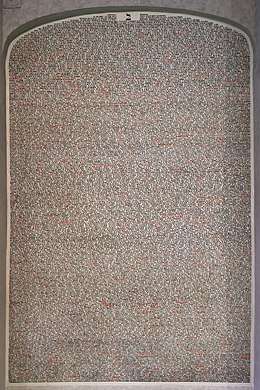
Background
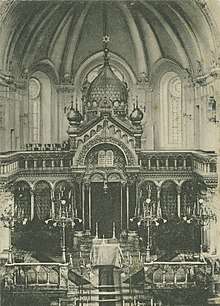
Before 1918, Bohemia and Moravia were part of the Austro-Hungarian Empire. In the nineteenth century, the Czech National Revival agitated for autonomy for the Czech-speaking majority. Following World War I, the Czech lands (including the border Sudetenland, which had a German majority) became part of the new country of Czechoslovakia.[2] During the 1890s, most Jews were German-speaking and considered themselves Germans.[3][4][5] By the 1930s, German-speaking Jews had been numerically overtaken by assimilated Jews speaking Czech;[6] Zionism also made inroads among the Jews of the periphery (Moravia and the Sudetenland).[7] In the late nineteenth and early twentieth century, thousands of Jews came to Prague from small villages and towns in Bohemia, leading to the urbanization of Bohemian Jewish society.[8] Of the 10 million inhabitants of pre-1938 Bohemia and Moravia, Jews composed only about 1% (117,551). Most Jews lived in large cities such as Prague (35,403 Jews, who made up 4.2% of the population), Brno (11,103, 4.2%), and Moravská Ostrava (6,865, 5.5%).[9]
Antisemitism in the Czech lands was lower than elsewhere and strongly opposed by the national founder and first president, Tomáš Garrigue Masaryk (1850–1937),[10][11] while secularism among both Jews and non-Jews facilitated integration.[12] Nevertheless, there had been isolated cases of anti-Jewish rioting during the birth of the Czechslovak republic in 1918 and 1920.[13][10] Following a steep decline in religious observance in the nineteenth century, most Bohemian Jews were indifferent to religion,[14] although this was less true in Moravia.[15] The Jews of Bohemia had the highest rate of intermarriage in Europe;[16] 43.8% married out of the faith compared to 30% in Moravia.[3] The high rate of integation—Czech Jews were the most integrated community in Europe—led to difficulties identifying Czech Jews for their later deportation and murder.[17]
During the mid-1930s, Czechoslovakia accepted thousands of German (and Austrian, after the Anschluss) Jews fleeing persecution, although right-wing politics eventually led to immigration restrictions and an end to racial persecution as a reason for seeking asylum.[18][19] Some ten thousand Austrian refugees were refused entry in 1938, and Polish Jews deported from Austria were shuttled to the Polish border.[20] Since the mid-1930s,[18] antisemitism was on the rise in Czechoslovakia. Some newspapers began to praise Der Stürmer. The right-wing government of the Second Czechoslovak Republic was increasingly under pressure from Germans—both its own German citizens and the external Nazi regime—and coped through accommodation.[21][22] Most of the 28,000 Jews living in the Sudeten areas annexed to Germany were expelled or fled into Czechoslovakia following Munich and Kristallnacht. The authorities tried to prevent them from crossing the border even though the Munich Agreement gave Sudeten Jews the option to retain their Czechoslovak citizenship. Some of the refugees had to wait for days in no-man's land.[23][24] In January 1939, Jews who had immigrated to Czechoslovakia after 1914 (including naturalized citizens) were ordered to be deported from the country. Fourteen thousand eventually left, saving their lives.[25] Meanwhile, Jews were excluded from Czech professional associations,[26] state hospitals dismissed Jewish doctors, and Jewish army officers were put on leave. German professional and educational institutions dismissed Jewish teachers and lecturers, while German newspapers laid off their Jewish reporters.[22] According to historian Wolf Gruner, the Second Republic's persecution of Jews "were independent developments influenced by radical Czech circles, and had little to do with any direct pressure imposed by Hitler".[25]
German occupation
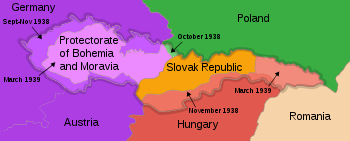
In September 1938, the Munich Agreement resulted in the annexation of the Sudetenland to Nazi Germany. Germany expelled Jews from the newly annexed territory, causing a surge in Jewish refugees and contributing to a rise in antisemitism. By December 1938, 15,186 Jewish refugees (including those expelled from the Sudetenland) were living in the remaining Czech territory.[27] On 14 March 1939, the Slovak State declared independence with German support. Carrying out plans made since October 1938, Germany invaded the Czech rump state, establishing the Protectorate of Bohemia and Moravia. This nominally autonomous protectorate was partially annexed into Nazi Germany.[28]
In the Protectorate, ethnic Germans were granted Reich citizenship and were accountable only to German authorities. Czechs and Jews were counted as Protectorate subjects, a second-class status, and were governed by the Czech puppet administration (in practice, under the control of the Reich Protector).[29] The Czech administration operated under Prime Minister Alois Eliáš (from April) and President Emil Hácha,[30] both of whom were conservative Catholics who approved anti-Jewish measures while retaining contact with the Czechoslovak government-in-exile. However, its justice minister, Jaroslav Krejčí, was known for his pro-Nazi sentiments. In March, Hácha formed the National Partnership, a political organization to which 98.5% of the adult male Protectorate citizens would belong (women and Jews were forbidden from joining).[31] The German administration was controlled by Konstantin von Neurath, former foreign minister of Germany, and Karl Hermann Frank, formerly the Deputy Chairman of the Sudeten German Party.[30]
At the time of the annexation, there were at least 118,310 Jews living in 136 recognized communities in the Protectorate.[32][30]
Persecution of Jews
The gradual persecution of Jews created a "ghetto without walls", in the words of Czech historian Miroslav Kárný, and created the conditions which enabled their deportation and murder later on.[17]
Initial measures
During the annexation, anti-Jewish riots occurred in a number of locations. In Olomouc, Vsetín, and Ostrava, synagogues were burned by German and Czech rioters. In Iglau (Jihlava) Jews were prohibited from riding streetcars and forced to clear snow from the streets. Prague Jewish organizations were shut down or taken over by the Gestapo, which also arrested thousands of left-wing activists and German refugees. More than a thousand were deported to concentration camps in the Reich; most of these were Jews.[32]
The Czech government largely remained in place and had considerable autonomy.[33] In the Protectorate, anti-Jewish persecutions were carried out by several agencies, including the Office of the Reich Protector, the Gestapo, and the Czech government.[34] The Eliáš government drafted the first ordinance on anti-Jewish legislation, which would have defined a "Jew" as someone with four Jewish grandparents who had belonged to a Jewish community after 1918. Jews would be barred from working in public agencies, corporations, schools, administrations, courts, stock exchanges, the arts, and medicine. However, the Reich Protector's office dismissed the proposal as too mild in its definition of "Jew", and therefore issued its own resolution on 21 June.[35] Part of the Czech government's calculation in arguing for a stricter definition of "Jew" was to reduce the amont of Jewish property that would be transferred to Germans as a result of Aryanization.[36] A second wave of synagogues—in Brno, Olomouc, Uherský Brod, Chlumec, Náchod, Pardubice, and Ostrava—were burned in May and June.[35]
Emigration
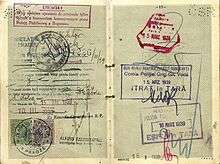
The growing poverty among Jews caused by the measures against them prevented their emigration, which was banned by the Security Service in May 1939. Therefore, the initial plan was not to create a Central Office for Jewish Emigration in Prague, as there was for Austria. The office was set up later on 15 July for the purpose of leveraging the property of Czech Jews to help the emigration of German Jews, and initially only controlled Prague and its surroundings.[37] Another office was considered for Brno.[38]
German historian Wolf Gruner estimates that before October 1941, 25,000 Jews managed to emigrate from Bohemia and Moravia.[1] Benjamin Frommer's estimate is that 14,000 Jews left before the Nazi invasion in 1939, and 30,000 legally left the country afterwards. Some of these were killed in countries that were later occupied by Germany. An unknown number (considered much smaller) fled illegally to Poland in 1939 or to Axis-aligned Slovakia and Hungary.[39] Jewish emigration was banned throughout the Reich on 16 October 1941.[40]
Nisko Plan
The outbreak of World War II with the September 1939 invasion of Poland dramatically changed the situation of Czech Jews.[41] The Nisko Plan was a scheme developed shortly after the September Campaign to concentrate Jews in the Lublin District, at the time the most remote area of German-occupied Europe and adjacent to the partition line with the Soviet Union.[42] SS leaders were planning to deport destitute 300,000 Jews from the Reich,[43][44] including 70,000 to 80,000 from the Kattowitz area (annexed from Poland) and the Moravská Ostrava region in the Protectorate.[41] For this purpose, a census was carried out which found that there were 90,147 Jews residing in the Protectorate as of 1 October 1939, 28,000 fewer than in March.[45]
On 18 October 1939, 901 men were deported from Ostrava to Nisko, in Poland. Border police and SS personnel accompanied the transport,[46] and Adolf Eichmann personally met it in Nisko.[45] The second transport carried 400 Jewish men from Ostrava and was accompanied by protests by local Czechs. The third took 300 men from Prague on 1 November, and was also protested by Czechs. It was turned around in Sosnowiec when the Nisko Plan was cancelled by SS chief Heinrich Himmler,[47][48] because it conflicted with the higher-priority goal of resettling Volksdeutsche in the Warthegau and West Prussia.[49] Transports were expected to resume in early 1940, but Reinhard Heydrich postponed them on 19 February in favor of deporting Polish Jews from the annexed areas.[50] In April 1940, the camp was dissolved and the 501 remaining prisoners, from Austria and the Protectorate, allowed to return home.[51]
Aryanization
Hermann Göring ordered that all Aryanization in the Protectorate take place with the approval of the Reich Ministry of the Economy, to avoid chaotic property transfers as had taken place in Vienna after the Anschluss. As a result, Jews were forbidden to sell companies and real estate. About 30,000 Jewish-owned businesses existed in the Protectorate, and Czechs and Germans fought over who would have the right to take them over. The Germans were favored and Aryanization was even extended to businesses owned by Czechs, leading Hácha to complain of "Germanization under the cloak of Aryanization".[52]
On 25 March, the Reich Interior Ministry decided to delegate "whether and what measures it undertakes against the Jews" to the Protectorate government. In the following weeks, professional associations of merchants, lawyers, and physicians took advantage of the antisemitic mood to expel their Jewish members. By June, the umbrella Jewish organization reported that many middle-class Jews had lost their jobs.[53] The Jewish Social Institute, a social welfare organization, was allowed to reopen on 6 April and provided relief to many unemployed Jews as well as refugees. By the summer of 1939 Jews were banned from any job except manual labor. At the time, 25,458 men and 24,028 women were of working age (18–45 years).[54] On 10 August, they were banned by order of the Reich Protector from all voting rights and public office, all positions involving the media and public opinion, and all Czech associations.[38] On 23 October, another order from the Reich Protector barred Jews from salaried employment.[50]
Further employment regulations were announced on 26 January 1940, with the result that Jews were banned from all management positions among other provisions. Increasing numbers of Jews were without employment or income.[55][50] Jews were required to register their business assets on 7 February and personal property on 16 March. The next two measures came from the Czech government: on 19 March Jews were excluded from the unemployment system and had to register at labor offices to receive unemployment assistance. Instead, they were recruited into locally organized forced labor, such as burning trash. On 24 April they were barred from working in law, education, pharmacies, medicine, or publishing.[56]
Restrictions on civil rights
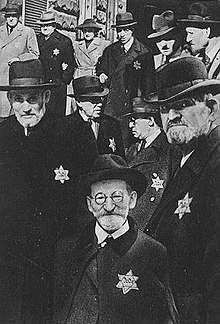
In January 1940, the remit of the Prague Central Office was extended to the entire Protectorate, and in March it obtained control of all Jewish communities, to which everyone classified as Jews according to the Nuremberg Laws were ordered to report even if they were not members of the Jewish community. Jews' freedom of movement was restricted with a curfew imposed after 20:00, and they were barred from visiting cinemas and theaters by the Hácha government. Protectorate identification cards for Jews were stamped with the red letter "J".[57] Jews were also restricted from shopping except a few hours of the day in mid-1940, and barred from schools on 7 August—both actions taken by the Czech government.[58][59] Throughout 1940, the Reich Protector received many petitions to require Jews to wear special markings such as a yellow star or armband, including from the National Aryan Cultural Association, a Czech antisemitic association. However, even though Jews were marked in the former Polish regions annexed into Nazi Germany, this was not approved for Bohemia and Moravia.[60][61]
In late 1940, Jewish-owned housing was registered in Prague and Brno, by the Central Office. By early the next year, Jews were being concentrated into "Judenhäuser" (lit. 'Jew houses').[62]
Forced labor
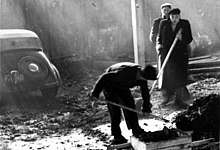
Plans for the employment of the Protectorate's Jews in forced labor in the event of war were drawn up before the occupation of the territory, in February 1939. It was expected to employ Jews in road-building and quarries, although what agency would be responsible was not decided.[63] However, in mid-1940, despite the increasing unemployment among Jews, the central authorities did not introduce any generalized forced labor program. Instead, muncipalities took the initiative and developed a forced labor program similar to that in Germany and Austria, but organized locally. In early July 1940, the town of Holešov requested premission to conscript its Jews into forced labor. A report in Neuer Tag magazine encouraged other localities to follow this practice. By July, 60% of Jewish men in the Protectorate were employed in forced labor projects and the remainder in independent employment that had not yet been barred to them. Unlike in Germany and Austria, Jews were not segregated from Czechs in forced labor because both were considered equally inferior.[64]
Forced labor deployments peaked in May 1942, at which point 15,000 men and 1,000 women were deployed. The numbers declined thereafter due to deportations to Theresienstadt Ghetto.[65]
At least 39 subcamps were located in the Protectorate. Tens of thousands of Jews and non-Jews were employed there, including many Polish and Hungarian Jews who had been deported there.[66]
Czech population
Many Czechs did not comply with the National Partnership's order that forbade Czechs from associating with Jews. These acts of defiance, as well as the public protests against deportation of the Jews in fall 1939, was closely related to their opposition to the German occupation.[67][36] The Security Service reported that during 1941, "the Czech attitude towards the Jews became a serious problem for the occupation authorities".[68] A minority of Czechs took part in the persecution of Jews.[69] The Czech fascist newspapers Vlajka and Arijský boj ("Aryan Struggle") were noted for their antisemitic invective and publishing denunciations of Jews and "Jew-lovers".[70] Frommer has argued that these newspapers made it easier for ordinary Czechs to denounce their neighbors, by providing an alternative to the Nazi authorities.[71] However, historian Jan Láníček argues that "the crude Czech anti-Semitic circles who actively collaborated with the Nazi authorities did not receive significant overt support among ordinary Czechs".[68]
Final Solution
Direct transports
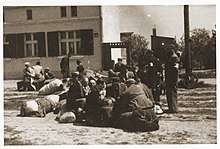
On 16 or 17 September 1941, Hitler approved a proposal to deport 60,000 Jews from the Reich and the Protectorate to Łódź Ghetto, in the Warthegau.[72][73] Due to overcrowding in the Łódź Ghetto, and partly to make space for the new arrivals, Kulmhof extermination camp was opened in fall 1941.[74] Twenty thousand Jews were eventually deported. Five transports with five thousand Jews departed from Prague on 16, 21, 26 and 30 October and 3 November, arriving in Łódź the next day.[75][76] One transport, on 16 November, took Jews from Brno to Minsk.[77] Unlike later transports, the passenger list had been drawn up by the Gestapo.[75]
Most of the deportees to Łódź were elderly, and by April 1942 sixteen percent had already died.[78] That month, Heinrich Himmler ordered the murder of 10,000 of the remaining Austrian, German, and Czech deportees: between 4 and 15 May, 10,993 Jews were deported in Kulmhof.[79] Only 277 of the Czech deportees survived the Łódź Ghetto and subsequent deportations to extermination camps.[80]
Theresienstadt Ghetto
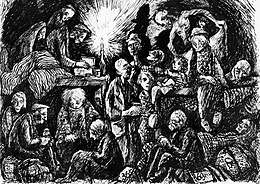
Deportation to Theresienstadt Ghetto, near the border between the Protectorate and Sudetenland, began in November 1941 with a transport of 350 men from Prague. The next month, more than 7000 people were deported to Theresienstadt, from Prague, Pilsen, Brno, and other places. From the outset, Theresienstadt was designated as a transit ghetto. The first transport left for Riga on 9 January 1942.[81][82]
Remaining Jews
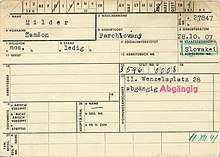
By the end of 1942, only 15,530 Jews remained in the Protectorate, 13% of the 1939 population. In June 1943, 4,000 Jewish Council employees and their families were sent to Theresienstadt in the last large deportation. By the end of 1944, only 6,795 Jews lived in the Protectorate, most of them in mixed marriages. Some of them were deported in early 1945 after the mixed marriage exception was cancelled.[83]
The number of Jews who survived in hiding is unknown. H. G. Adler estimated it at 424, but Livia Rothkirchen and Miroslav Kárný argued that incidents of hiding and rescue was significantly higher. According to Frommer, the limited evidence that exists suggests that hiding was relatively rare in the Protectorate.[84]
Aftermath
Two to three thousand Jews who had identified themselves as Germans on prewar censuses could not regain their Czechoslovak citizenship and were to be expelled along with ethnic Germans. This group included some veterans of the Czechoslovak forces in exile.[85] In addition, ordinary Czechs often did not distinguish between "good" and "bad" Germans and subjected them to the same extrajudicial measures, including physical attacks.[86] Due to discrimination, thousands of Jews applied to leave the country voluntarily.[87] The deportation of Jews was abruptly halted in September 1946 due to media outrage and objections from the military governor of the American occupation zone of Germany.[88] However, the situation was so bad that by 1947 many of the Jews wished that they had been deported.[89]
In the 1952 Slánský trial, fourteen Communists (eleven Jewish—including Holocaust survivors) were accused of belonging to a Zionist conspiracy. Eleven of them were executed.[90][91]
As of 2019, about 3,900 Jews live in the Czech Republic.[92]
Legacy
.jpg)
After the 1989 Velvet Revolution which resulted in the fall of the Communist regime, scholarly interest in the Holocaust greatly increased, which many academic theses relating to the Holocaust being published. The interest peaked around 2000 and has declined since.[93]
The Czech Republic is one of the only countries to have a government office dedicated to post-Holocaust issues.[94]
Jiří Weil and Arnošt Lustig, both Holocaust survivors, became known for their literature on the event.
References
Citations
- Gruner 2015, p. 121.
- Osterloh 2015, p. 68.
- Čapková 2012, p. 22.
- Rothkirchen 2006, p. 18.
- Gruner 2015, p. 99.
- Čapková 2012, p. 152.
- Čapková 2012, p. 250.
- Čapková 2012, pp. 17, 24–25.
- Gruner 2015, p. 101.
- Gruner 2015, p. 100.
- Čapková 2012, p. 25.
- Čapková 2012, p. 24.
- Rothkirchen 2006, pp. 27–28.
- Čapková 2012, pp. 16, 22.
- Rothkirchen 2006, p. 34.
- Rothkirchen 2006, p. 49.
- Frommer 2014, p. 137.
- Gruner 2015, p. 102.
- Frankl 2014, p. 547.
- Frankl 2014, p. 549.
- Rothkirchen 1999, p. 3.
- Gruner 2015, p. 103.
- Frankl 2014, pp. 549–550.
- Osterloh 2015, p. 76.
- Gruner 2019, p. 43.
- Frankl 2014, p. 550.
- Gruner 2015, pp. 102–103.
- Gruner 2015, pp. 103–104.
- Gruner 2015, pp. 104–105.
- Gruner 2006, p. 141.
- Gruner 2015, pp. 106, 108.
- Gruner 2015, p. 106.
- Gruner 2019, p. 66.
- Gruner 2006, p. 142.
- Gruner 2015, pp. 108–109.
- Láníček 2013, p. 18.
- Gruner 2006, p. 144.
- Gruner 2006, p. 145.
- Frommer 2019, p. 39.
- Browning 2007, p. 197.
- Gruner 2006, p. 146.
- Browning 2007, pp. 12, 37.
- Browning 2007, pp. 39–40.
- Gruner 2006, pp. 146–147.
- Gruner 2006, p. 147.
- Gruner 2015, p. 111.
- Gruner 2015, pp. 111–112.
- Browning 2007, p. 41.
- Browning 2007, p. 43.
- Gruner 2015, p. 112.
- Browning 2007, p. 42.
- Gruner 2015, pp. 107, 109.
- Gruner 2015, pp. 107–108.
- Gruner 2006, pp. 143–144.
- Gruner 2006, pp. 148–149.
- Gruner 2015, p. 113.
- Gruner 2006, p. 148.
- Gruner 2006, p. 150.
- Gruner 2015, p. 114.
- Gruner 2006, pp. 150–151.
- Gruner 2015, pp. 113–114.
- Gruner 2015, pp. 114–115.
- Gruner 2006, pp. 141–142.
- Gruner 2006, pp. 149–150.
- Gruner 2015, p. 119.
- Gruner 2015, p. 134.
- Gruner 2015, pp. 112, 114.
- Láníček 2013, p. 17.
- Láníček 2013, p. 20.
- Frommer 2014, pp. 139–140.
- Láníček 2013, pp. 17–18.
- Browning 2007, p. 325.
- Witte 1995, p. 330.
- Browning 2007, p. 366.
- Gruner 2015, p. 117.
- Browning 2007, pp. 375–376.
- Browning 2007, p. 376.
- Witte 1995, p. 333.
- Witte 1995, p. 336.
- Terezín Initiative 2011.
- Gruner 2015, p. 118.
- Blodig & White 2012, p. 181.
- Gruner 2015, pp. 120–121.
- Frommer 2019, pp. 37, 40.
- Čapková 2018, p. 69.
- Čapková 2018, p. 71.
- Čapková 2018, pp. 74–75.
- Čapková 2018, pp. 79–80.
- Čapková 2018, p. 83.
- Sniegon 2014, p. 61.
- Wein 2015, p. 159.
- Bazyler et al. 2019, p. 103.
- Frankl 2017, p. 262.
- Bazyler et al. 2019, p. 105.
Sources
Books
- Browning, Christopher R. (2007). The Origins of the Final Solution: The Evolution of Nazi Jewish Policy, September 1939 – March 1942. University of Nebraska Press. ISBN 978-0-8032-0392-1.
- Čapková, Kateřina (2012). Czechs, Germans, Jews?: National Identity and the Jews of Bohemia. Berghahn Books. ISBN 978-0-85745-475-1.
- Gruner, Wolf (2006). Jewish Forced Labor Under the Nazis: Economic Needs and Racial Aims, 1938-1944. Cambridge University Press. ISBN 978-0-521-83875-7.
- Gruner, Wolf (2019). The Holocaust in Bohemia and Moravia: Czech Initiatives, German Policies, Jewish Responses. Berghahn Books. ISBN 978-1-78920-285-4.
- Láníček, Jan (2013). Czechs, Slovaks and the Jews, 1938-48: Beyond Idealisation and Condemnation. Springer. ISBN 978-1-137-31747-6.
- Rothkirchen, Livia (2006). The Jews of Bohemia and Moravia: Facing the Holocaust. University of Nebraska Press. ISBN 978-0803205024.
- Sniegon, Tomas (2014). Vanished History: The Holocaust in Czech and Slovak Historical Culture. Berghahn Books. ISBN 978-1-78238-295-9.
- Wein, Martin (2015). A History of Czechs and Jews: A Slavic Jerusalem. Routledge Jewish Studies Series. Routledge. ISBN 978-1-317-60821-9.
Book chapters
- Bazyler, Michael J.; Boyd, Kathryn Lee; Nelson, Kristen L.; Shah, Rajika L. (2019). "Czech Republic". Searching for Justice after the Holocaust: Fulfilling the Terezin Declaration and Immovable Property Restitution. Oxford University Press. pp. 103–116. ISBN 978-0-19-092306-8.
- Blodig, Vojtěch; White, Joseph Robert (2012). "Protectorate of Bohemia and Moravia". In Geoffrey P., Megargee; Dean, Martin (eds.). Ghettos in German-Occupied Eastern Europe. Encyclopedia of Camps and Ghettos, 1933–1945. 2. United States Holocaust Memorial Museum. pp. 177–184. ISBN 978-0-253-00202-0.
- Frankl, Michal (2013). "The Sheep of Lidice: The Holocaust and the Construction of Czech National History". In Himka, John-Paul; Michlic, Joanna Beata (eds.). Bringing the Dark Past to Light. The Reception of the Holocaust in Postcommunist Europe. University of Nebraska Press. pp. 166–194. ISBN 978-0-8032-2544-2.
- Frommer, Benjamin (2014). "Verfolgung durch die Presse: Wie Prager Büroberater und die tschechische Polizei die Juden des Protektorats Böhmen und Mähren isolieren halfen" [Persecution by the Press: How Prague Bureaucrats and the Czech Police Helped to Isolate the Jews of the Protectorate of Bohemia and Moravia]. In Löw, Andrea; Bergen, Doris L.; Hájková, Anna (eds.). Alltag im Holocaust: Jüdisches Leben im Großdeutschen Reich 1941–1945 [Everyday Life during the Holocaust: Jewish Lives in the Greater German Reich, 1941–1945] (in German). Walter de Gruyter GmbH. pp. 137–150. ISBN 978-3-486-73567-3.
- Frommer, Benjamin (2019). "The Saved and the Betrayed: Hidden Jews in the Nazi Protectorate of Bohemia and Moravia". In Kohen, Ari; Steinacher, Gerald (eds.). Unlikely Heroes: The Place of Holocaust Rescuers in Research and Teaching. University of Nebraska Press. pp. 37–56. ISBN 978-1-4962-1632-8.
- Gruner, Wolf (2015). "Protectorate of Bohemia and Moravia". In Gruner, Wolf; Osterloh, Jörg (eds.). The Greater German Reich and the Jews: Nazi Persecution Policies in the Annexed Territories 1935–1945. War and Genocide. Translated by Heise, Bernard. Berghahn Books. pp. 99–135. ISBN 978-1-78238-444-1.
- Osterloh, Jörg (2015). "Sudetenland". In Gruner, Wolf; Osterloh, Jörg (eds.). The Greater German Reich and the Jews: Nazi Persecution Policies in the Annexed Territories 1935–1945. War and Genocide. Translated by Heise, Bernard. Berghahn Books. pp. 99–135. ISBN 978-1-78238-444-1.
- Veselská, Magda (2014). ""Sie müssen sich als Jude dessen bewusst sein, welche Opfer zu tragen sind... " Handlungsspielräume der jüdischen Kultusgemeinden im Protektorat bis zum Ende der großen Deportationen" ["As a Jew, You Have to Be Aware of What Sacrifices Must Be Made ..." the Freedom of Action of the Jewish Cultural Communities in the Protectorate Until the End of the Large Deportations]. In Löw, Andrea; Bergen, Doris L.; Hájková, Anna (eds.). Alltag im Holocaust: Jüdisches Leben im Großdeutschen Reich 1941–1945 [Everyday Life during the Holocaust: Jewish Lives in the Greater German Reich, 1941–1945] (in German). Walter de Gruyter GmbH. pp. 151–166. ISBN 978-3-486-73567-3.
Journal articles
- Čapková, Kateřina (2018). "Between Expulsion and Rescue: The Transports for German-speaking Jews of Czechoslovakia in 1946". Holocaust and Genocide Studies. 32 (1): 66–92. doi:10.1093/hgs/dcy005. ISSN 8756-6583.
- Frankl, Michal (2014). "Prejudiced Asylum: Czechoslovak Refugee Policy, 1918–60". Journal of Contemporary History. 49 (3): 537–555. doi:10.1177/0022009414528260. ISSN 1461-7250.
- Frankl, Michal (2017). "Free of Controversy? Recent Research on the Holocaust in the Bohemian Lands". Dapim: Studies on the Holocaust. 31 (3): 262–270. doi:10.1080/23256249.2017.1371725. ISSN 2325-6249.
- Přibyl, Lukáš (2000). "Das Schicksal des dritten Transports aus dem Protektorat nach Nisko" [The Fate of the Third Transport from the Protectorate to Nisko]. Theresienstädter Studien und Dokumente (in German) (7): 297–342. CEEOL 186410.
- Rothkirchen, Livia (1999). "The Protectorate Government and the "Jewish Question" 1939–1941". Yad Vashem Studies. XXVII: 331–362. From an online version paginated 1–25.
- Witte, Peter (1995). Translated by Richardson, B. "Two Decisions Concerning the "Final Solution to the Jewish Question": Deportations to Lodz and Mass Murder in Chelmno". Holocaust and Genocide Studies. 9 (3): 318–345. doi:10.1093/hgs/9.3.318.
Other
- Brade, Laura (2017). Christopher R. Browning; Chad Bryant; Konrad Jarausch; Donald Raleigh; Susan Pennybacker; Karen Auerbach (eds.). Networks of Escape: Jewish Flight from the Bohemian Lands, 1938-1941 (PhD thesis). University of Chapel Hill. doi:10.17615/apr3-3m30.
- "The Łódź ghetto". Terezín Initiative. 5 September 2011. Retrieved 3 January 2020.
Further reading
- Bondy, Ruth (2008). Trapped: Essays on the History of the Czech Jews, 1939–1945. Translated by Naor, Chaya. Jerusalem: Yad Vashem. ISBN 978-965-308-322-6.
- Kárný, Miroslav (1991). "Konečné řešení": genocida českých Židů v německé protektorátní politice [“Final Solution”: The Genocide of Czech Jews in German Protectorate Policy] (in Czech). Prague: Academia. ISBN 978-80-200-0389-8.